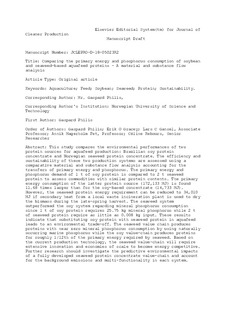| dc.contributor.author | Philis, Gaspard | |
| dc.contributor.author | Gracey, Erik Olav | |
| dc.contributor.author | Gansel, Lars Christian | |
| dc.contributor.author | Fet, Annik Magerholm | |
| dc.contributor.author | Rebours, Celine | |
| dc.date.accessioned | 2019-03-13T08:37:12Z | |
| dc.date.available | 2019-03-13T08:37:12Z | |
| dc.date.created | 2018-08-23T18:32:53Z | |
| dc.date.issued | 2018 | |
| dc.identifier.citation | Journal of Cleaner Production. 2018, 200 1142-1153. | nb_NO |
| dc.identifier.issn | 0959-6526 | |
| dc.identifier.uri | http://hdl.handle.net/11250/2589792 | |
| dc.description.abstract | This study compares the environmental performances of two protein sources for aquafeed production: Brazilian soy protein and Norwegian seaweed protein concentrates. The efficiency and sustainability of these two production systems are assessed using a comparative material and substance flow analysis accounting for the transfers of primary energy and phosphorus. The primary energy and phosphorus demand of 1 t of soy protein concentrate is compared to 2 t seaweed protein concentrate to assess commodities with similar protein contents. The primary energy consumption of the latter protein source (172,133 MJ) is found 11.68 times larger than for the soy-based concentrate (14,733 MJ). However, the seaweed protein energy requirement can be reduced to 34,010 MJ if secondary heat from a local waste incineration plant is used to dry the biomass during the late-spring harvest. The seaweed system outperformed the soy system regarding mineral phosphorus consumption since 1 t of soy protein requires 25.75 kg mineral phosphorus while 2 t of seaweed protein require as little as 0.008 kg input. These results indicate that substituting soy protein with seaweed protein in aquafeed leads to an environmental trade-off. The seaweed value chain produces proteins with near zero mineral phosphorus consumption by using naturally occurring marine phosphorus while the soy value-chain produces proteins for roughly 1/12th of the primary energy required by seaweed. Based on the current production technology, the seaweed value-chain will require extensive innovation and economies of scale to become energy competitive. Further research should investigate the predictive environmental impacts of a fully developed seaweed protein concentrate value-chain and account for the background emissions and multi-functionality in each system. | nb_NO |
| dc.language.iso | eng | nb_NO |
| dc.publisher | Elsevier | nb_NO |
| dc.rights | Attribution-NonCommercial-NoDerivatives 4.0 Internasjonal | * |
| dc.rights.uri | http://creativecommons.org/licenses/by-nc-nd/4.0/deed.no | * |
| dc.title | Comparing the primary energy and phosphorus consumption of soybean and seaweed-based aquafeed proteins – A material and substance flow analysis | nb_NO |
| dc.type | Journal article | nb_NO |
| dc.type | Peer reviewed | nb_NO |
| dc.description.version | acceptedVersion | nb_NO |
| dc.source.pagenumber | 1142-1153 | nb_NO |
| dc.source.volume | 200 | nb_NO |
| dc.source.journal | Journal of Cleaner Production | nb_NO |
| dc.identifier.doi | 10.1016/j.jclepro.2018.07.247 | |
| dc.identifier.cristin | 1604152 | |
| dc.relation.project | Norges forskningsråd: 244244 | nb_NO |
| dc.description.localcode | © 2018. This is the authors’ accepted and refereed manuscript to the article. Locked until 30.7.2020 due to copyright restrictions. This manuscript version is made available under the CC-BY-NC-ND 4.0 license http://creativecommons.org/licenses/by-nc-nd/4.0/ | nb_NO |
| cristin.unitcode | 194,66,45,0 | |
| cristin.unitcode | 194,60,25,0 | |
| cristin.unitname | Institutt for biologiske fag Ålesund | |
| cristin.unitname | Institutt for industriell økonomi og teknologiledelse | |
| cristin.ispublished | true | |
| cristin.fulltext | original | |
| cristin.fulltext | postprint | |
| cristin.qualitycode | 2 | |

